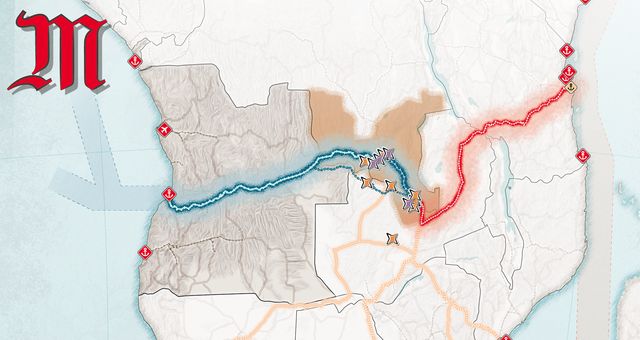This week, in « Moving Maps, » Delphine Papin focuses on Angola, the new gateway for Westerners to Africa.
Why does this country interest major European powers?
This country is ideally located: it has a direct opening to the Atlantic Ocean, a key position between Central and Southern Africa, and most importantly… it is moving away from Chinese influence.
This week, our map is centered on Southern Africa. We see three countries closely linked by geography and economic stakes.
First, Angola has a major asset: a wide opening to the Atlantic Ocean, a true gateway to international markets. To the north of Angola is the Democratic Republic of the Congo (DRC), and further east, Zambia. These two countries benefit from an exceptional subsoil with copper, cobalt… raw materials that have become essential for the energy transition: for our batteries, solar panels, semiconductors… In short, this area of strategic minerals is somewhat the current vault of Africa.
Three countries and a strategic mining space, but far from the coasts: this is where geography comes fully into play. The whole issue is to figure out how to get the contents of this vault out of the continent? The mining areas of the DRC and Zambia are approximately equidistant from the Atlantic coast and the Indian Ocean coast.
Today, to export them, they must be transported by truck and rail to very distant ports, in Mozambique or South Africa, journeys that sometimes take more than a month. Therefore, to meet the growing industrial demand, it is necessary to find faster routes.
The first axis you see in blue on the map is the route favored by Westerners: the “Lobito Corridor.” This corridor follows the path of the Benguela Railway, built between 1902 and 1929, when Angola was still a Portuguese colony.
It starts from the port of Lobito on the Atlantic coast. It crosses Angola’s plateaus, savannahs, and forests, passes through the borders of the DRC, then Zambia, and reaches the mineral-rich regions of what is called the Copperbelt.
And recently, Europeans and Americans have won the market, at the expense of the Chinese, who were well-established in Angola.
So, it’s a great win for the Westerners, especially when we know how much infrastructure plays a decisive role in geopolitical influence in Africa. And if the Westerners have succeeded, it’s mainly because Angola wants to break free from China’s dependence, which has been closely tied to the era of José Eduardo dos Santos, president of Angola from 1979 to 2017.
Angola was one of the first African countries to borrow from Beijing in 2002, after the civil war. It is also one of the first to find itself trapped by debt. Of the 45 billion dollars in Chinese loans, it still owes 17 billion, making it one of the main African debtors. Thanks to these Chinese loans, Angola has financed sometimes oversized infrastructures, such as its new international airport in Luanda. An airport designed to handle 15 million passengers, in a country where people struggle to travel to the neighboring city due to a lack of a viable road network.
Luanda guaranteed these Chinese loans not with bills but with barrels of oil, as Angola is one of the top oil producers in Africa. But with the drop in oil prices, the situation is worrying, and Angola devotes more than a quarter of its public revenue solely to paying the interest on this debt. This is why Luanda wants to extricate itself from Beijing’s grasp.
Should China then focus more on the eastern part of the African continent, towards the Indian Ocean?
China is now supporting the modernization of another railway axis, the Tazara line, which links Zambia to the Tanzanian port of Dar es Salaam.
This line was built by the People’s Republic of China under Mao Zedong in the 1970s to create an export route to China for the minerals of newly independent African states.
In 2024, China, Tanzania, and Zambia signed an agreement to rehabilitate it. And this corridor is in direct competition with the Lobito Corridor.
So, in summary: two corridors, two visions of development… and an Africa at the center of a new global influence game, especially since the continent’s influences are being redrawn.
After launching its ambitious Belt and Road initiative in 2013, China, as we have seen, expanded its influence across the continent through loans and infrastructure projects.
In the Sahel, Western powers are increasingly unwelcome. France has been ousted from what it considered its backyard, replaced by Russia.
And in South Africa, relations with Russia are also strengthening.
Angola, however, appears as an exception: a land of openness, a new gateway for Europeans and Americans, who had disengaged from the continent since the 1990s.
Source: radiofrance




